What is a thunderstorm and lightning strike
A thunderstorm is an atmospheric phenomenon characterized by heavy precipitation, thunder, gusty winds and lightning strikes. Its harbingers are cumulonimbus clouds, the characteristic feature of which is their dark color and oblong, elongated shape.
Lightning voltage
Lightning is one of the manifestations of a strong thunderstorm. This is an electrical atmospheric discharge that can cause a fire. Its voltage is up to 100 million V, accompanied by a shock wave of sound (thunder) and a bright light flash of a bizarre shape. On average, its length is up to 2.5 km.
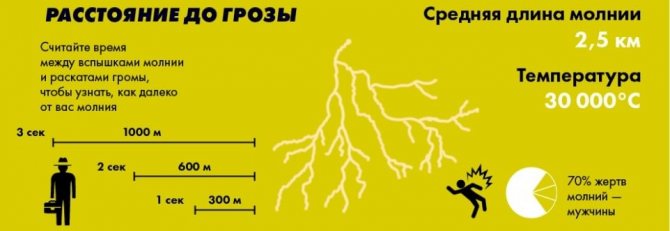
How to calculate the distance to a thunderstorm
When lightning strikes a person, the first to be affected are the internal organs, especially those that contain air. A sharp contraction of muscles under the influence of an electric current of such power can lead to bone fractures, including the spine. Stunning, loss of orientation, shock, paralysis and death - these can be the consequences for a person from a lightning strike.
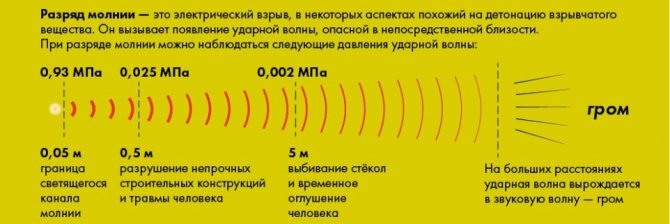
What is lightning strike
According to statistics, about 70% of her victims are men. Knowing and following basic safety rules during a thunderstorm can prevent many tragic accidents.
What not to do during a thunderstorm
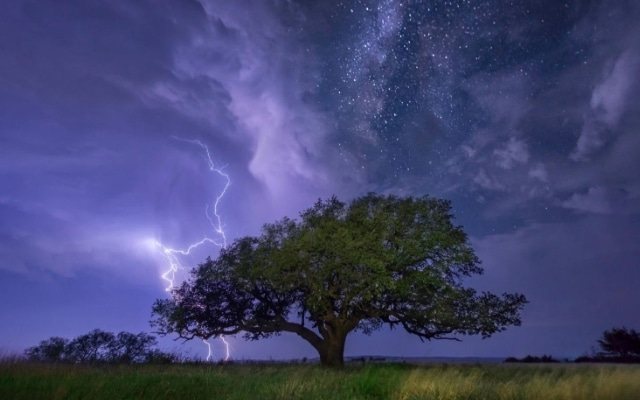
In accordance with the above, you can define rules for what not to do during a thunderstorm:
- You cannot take cover under lonely objects in an open area - a tree, a high-voltage pole, or other tall structures located at a great distance from others.
- Use a mobile phone, especially at a great distance from houses and other structures. This is explained by the fact that electromagnetic waves attract an electric discharge, and there are known cases of lightning striking the mobile phone of a person who was talking on it at the time. However, in urban environments such cases are rare.
- Ride a bicycle in open areas.
- Do not press against or be in other close proximity to metal objects outdoors.
- You should not immediately take shelter from the rain. Clothing that is wet is less likely to be struck by lightning than clothing that is dry.
- Do not lie on the ground or run from a thunderstorm while in open areas. In the first case, having struck the ground, lightning can also hit a person, and in the second, he becomes a kind of fast-moving target.
- Talk on the phone with a wired connection, since lightning can strike between the stretched wires of the poles.
- During a thunderstorm, do not go near electrical wiring, lightning rods, roof drainpipes, television or radio antennas, and it is also not recommended to stand near an open window.
In open areas
If you find yourself in an area where there is absolutely no place to hide from an approaching thunderstorm (plain, field), then first determine how far the lightning is from you. To do this, you should note the time that passes between the flash and the heard clap of thunder. If the time is 3 seconds, then the distance will be 1000 m, 2 seconds - 600 m, but 1 second. indicates that a natural electrical source is only 300 m away from you.

Outdoor Safety
Your safety during a thunderstorm will depend on what you do correctly. The main and most common errors:
- Trying to hide under a lonely tree or haystack
- Run, walk or stand upright
- Search and climb any height
In order to wait out a thunderstorm in an open area, you should find some kind of lowland (a hole, a ravine) or simply squat down, but not lie on the ground. The distance from tall, lonely objects should be at least 200 m. Remember that a lightning strike usually selects the tallest objects, and if you find yourself in an open area, you will be one of them. Do not go near bodies of water and do not use your phone; it is better to turn it off.
Basic Safety Rules
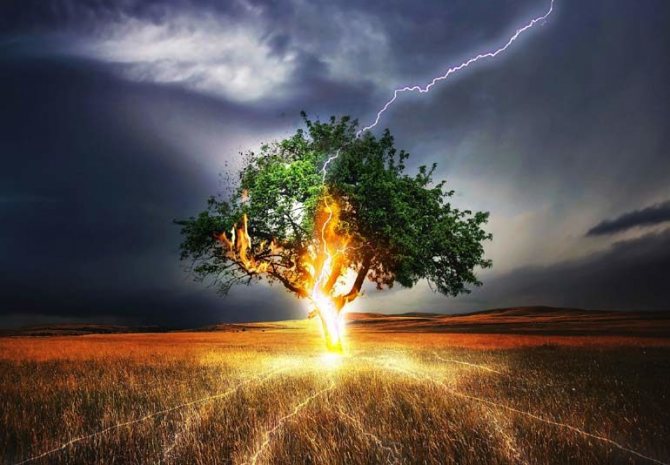
In the steppe or meadows, in the taiga or near a mountain river, while climbing to the peaks, the probability of being caught in bad weather is the same as in the city, but you should prepare more seriously.
Since lightning strikes pose the greatest danger during a thunderstorm, it is worth considering their “favorite” natural sites:
- lone trees - most often take a lightning strike, and the species matters : - oaks - 55% of hits; — poplars – 23%; – spruce – 10%; - birch, beech, linden - 1-3%.
- objects that can attract discharge: - wet clothes; - moped, motorcycle or bicycle; — umbrella on an iron frame; - mobile phone; - tools; - keys or jewelry; - any metal products: ribs of tents, wires for drying clothes, dishes and other camping equipment.
With such knowledge they set up a bivouac:
- away from bodies of water at a minimum distance of 100 m (it extinguishes the water discharge);
- away from oak or pine giants - at least 4-5 m.
When it is obvious that the elements cannot be avoided, standard norms of behavior are required in any natural conditions:
- empty your pockets of metal items and wear clothes with plastic fasteners and fittings - in a rarefied atmosphere, even non-conductors or the smallest parts can attract concentrated energy;
- do not go into empty spaces in a field, meadow or clearing - the beam finds the highest point for discharge, and here the person himself becomes a noticeable peak;
- do not get close to bodies of water or even containers with liquid - electrolytes organically receive heavenly “irritation” and transmit it further: to people, if they are nearby;
- limit conversations on the phone or radio - magnetic waves are of the same nature as thunderstorm current, and like is drawn to like.
Video on safety rules during a thunderstorm from employees of the Ministry of Emergency Situations of Belarus
How to provide first aid for a hogweed burn.
In the forest

Rules for behavior in the forest during a thunderstorm
In forest areas, it is safest to find shelter under small bushes. If there are no small bushes nearby, then there should be a distance of at least 4-5 m between the trees and you. You need to sit down in a fetal position.
You should know that just because a tree is strong and powerful, this does not mean that it can withstand a lightning strike and provide you with reliable shelter. According to statistics, most often the “victims” of thunderstorms are oaks, spruces and poplars; lightning is one of the causes of fires in the forest.

Which trees are most often struck by lightning?
There is no need to light a fire until the thunderstorm has completely stopped, because... fire can attract electrical discharges.
Thunderstorm caught in transport
If you are riding a bicycle or motorcycle, you are the highest point that lightning can strike. So you need to go down to the ground and wait out the thunderstorm at a distance of 30 meters from the vehicle.
If you're driving a car, consider yourself lucky. Turn off the radio, close all windows, lower the antenna. It's best to park on the side of the road. It is unsafe to move during a thunderstorm, because it is usually accompanied by rain, which impairs visibility, and a flash of lightning can even blind you.
If you are on public transport, there is no need to be afraid. With complete insulation of the cabin, neither the driver nor the passengers will be harmed. Trams and trolleybuses have “horns” into which lightning strikes, but inside they are insulated with rubber, like handrails and seats. In addition, electric vehicles have a lightning arrester that protects the engine.
The same goes for the airplane. Metal cladding protects passengers.
Near a pond or lake
Water is an excellent conductor of electricity, so during a thunderstorm you should immediately leave the pond and move away from it to a safe distance (at least 100 m). You shouldn’t wait it out on the shore in a tent or hiding under trees.

Thunderstorm safety near water
If a natural phenomenon finds you in a boat, and it’s far away from the shore, follow the following rules:
- Wet clothing can also attract lightning, as can the water surface of a body of water, so sit on anything dry. A life jacket will also work.
- Cover yourself from above with an awning or cellophane, but in such a way that it never touches the water.
In addition to water and wet clothes, the following things can attract lightning: a working mobile phone, an umbrella (especially knitting needles and a rod), any metal items (keys, tools).

What things attract lightning in a thunderstorm?
If you come on vacation in a car, you can wait out the bad weather in it. You should close the windows, do not turn on the engine and lower the radio antenna. No need to touch door handles or keys.
What to do if there is a thunderstorm
Since the elements are unpredictable, and there are places that provoke a person to be struck by lightning, you should know what to do during a thunderstorm if you find yourself in an unsafe place.
In the forest
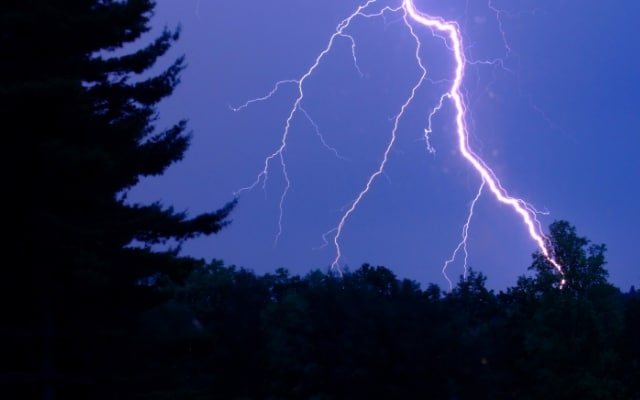
If you are in the forest during a thunderstorm, you must avoid the proximity of trees such as oak, pine, and poplar. According to statistics, they are the ones who most often attract lightning strikes, which is why forest fires occur because of them. You need to find a low-growing area of the forest and hide there, squatting down and taking a fetal position. Trees themselves are natural lightning rods, so you should avoid being near tall trees.
The ideal option to protect yourself is to find an area with low-growing trees and dense crowns, hide between them, sitting on the ground.
If at the same time it is necessary to move, this must be done without moving away from them further than the height of the crowns. You cannot choose places for shelter near trees that have previously been struck by lightning. The soil around them indicates high electrical conductivity, which means the likelihood of a repeat lightning strike. In addition, when spending the night during a thunderstorm, you should not put up a tent in an open area, or sit near a fire, because smoke conducts electricity very well.
In field

If you find a thunderstorm in a field, you need to hide in some kind of depression - a ravine, a hole, you need to squat down, bending your head to your knees. You should try to stay away from tall single objects and structures at a distance of at least 200 meters. You should not use a telephone or any metal products to avoid attracting lightning strikes. When in the field, you should know that clay soil is more dangerous than rocky or sandy soil. Therefore, under no circumstances should you lie down on the ground if it is clayey.
On the water
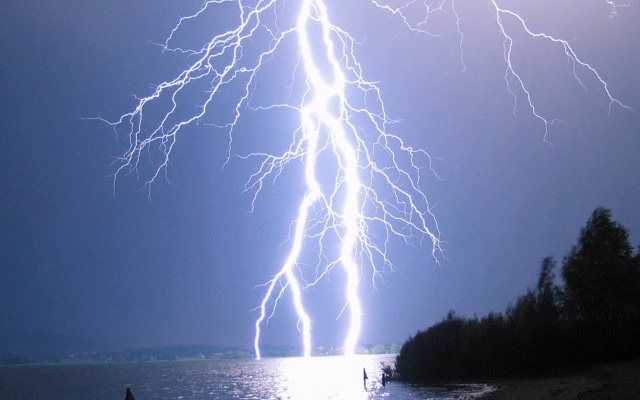
It is especially dangerous to be near a body of water during a thunderstorm, but if it so happens that you did not have time to leave the beach, you should make immediate attempts to do this, and even more so, immediately get out of the water. When you are inside the boat, you should immediately land on shore; if this is not possible, you need to change into dry clothes, dry the boat, make protection from an awning, cover yourself with it, put a life jacket, ring, rubber boots, and other insulating items around and under you. The awning should protect the boat from water penetration, but not touch the surface of the reservoir.
In a private house
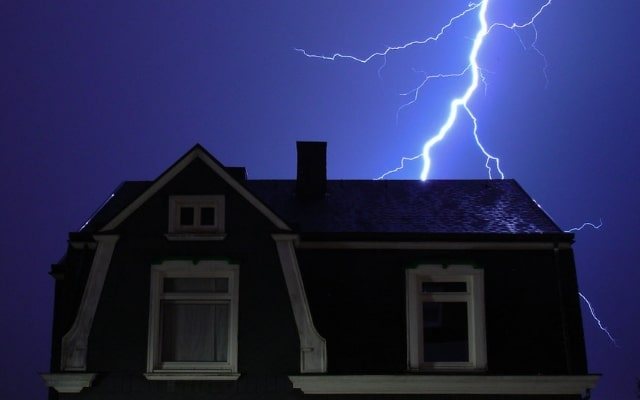
Multi-storey buildings are protected from lightning thanks to lightning rods, but private houses and garden houses are in the danger zone. To avoid danger, measures must be taken:
- Close all windows and doors. Ball lightning can get inside the house.
- Disconnect all electrical appliances and radios from the electrical network.
- Stop heating the stove and close the chimney.
- Disable all communications
- Move away from windows, doorways, metal objects, sockets.
On road

If a thunderstorm occurs while driving a car, you need to stop driving away from single objects and desert areas. You should close all windows, hide the antenna, turn off the radio, navigator, and cellular communications. Avoid touching metal objects inside the car, including door handles.
In the mountains
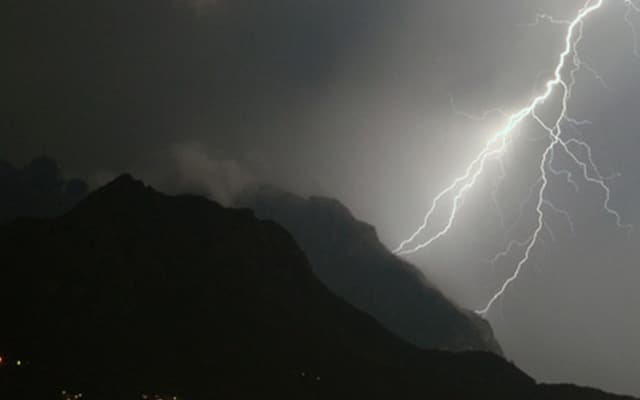
Thunderstorm in the mountains
If you are in a mountainous area, you should immediately descend from the hills, move away from drains and waterfalls, it is best to stand under a plumb line that is 5-6 times the height of a person. You should stand no closer than 2 meters to the plumb line. Shelter in crevices and caves is also suitable, but no closer than two meters from the walls. During a thunderstorm, you should not lean against rock walls or handle metal equipment.
In room
As a rule, thanks to lightning rods, a room is the safest place to wait out a thunderstorm. But, there is the option of encountering ball lightning, which can often enter any room through open vents, windows and doors. In case you are waiting out a natural phenomenon at home:
- Eliminate any drafts by closing all windows and doors. Don't forget the chimney.
- Do not use a telephone, including a landline. The same applies to a fireplace or stove. Smoke from the chimney can attract thunderstorms.
- Turn off all electrical appliances and do not go near electrical wiring, sockets or panels
- Don't be near windows
- Take off your jewelry
What not to do during a thunderstorm if you stay indoors
If strong lightning strikes occur while a person is indoors, it is important to follow some basic rules and regulations. First of all, it is important to disconnect all electrical appliances from the power supply. It is also worth removing the antenna connectors. The strength of a single thunderstorm discharge can range from 2,000 to 300,000 Amperes. No household appliance can withstand such current. There is no need to leave balcony doors and windows open. It is not recommended to be near an open window or balcony. During lightning strikes, do not touch metal plumbing fixtures. To reliably protect buildings from electrical storms, it is best to use professional lightning protection systems, which our specialists are always ready to install.











